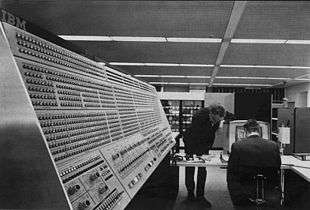IBM System/360 Model 91
 | |
| Developer | IBM |
|---|---|
| Release date | January 1966 |
| Predecessor | IBM 7090 |
| Successor | Model 195 |
The IBM System/360 Model 91 was announced in 1964 as a competitor to the CDC 6600.[1] The Model 91 runs functionally like any other large scale System/360 but the internal organization is the most advanced and it was the first IBM computer supporting out-of-order instruction execution.[2] It ran OS/360 as its operating system. It was designed to handle high-speed data processing for scientific applications. This included space exploration, theoretical astronomy, sub-atomic physics and global weather forecasting.[3]
The first Model 91 was used at the NASA Goddard Space Flight Center in 1968 and at the time was the most powerful computer in user operation. It was capable of performing up to 16.6 million instructions a second.[3]
The CPU consisted of five autonomous units: instruction, floating-point, fixed-point, and two storage controllers for the overlapping memory units and the I/O data channels. The floating-point unit made heavy use of instruction pipelining[4] and was the first implementation of Tomasulo's algorithm. It was also one of the first computers to utilize Multi-channel memory architecture.
There were only 15 Model 91's ever produced, 4 of which were for IBM's personal use.[5]
The launch of the System/360 family introduced IBM's Solid Logic Technology (SLT), a new technology that was the start of more powerful but smaller computers.[6]

IBM and NASA

IBM had a long history with NASA including the use of IBM components on manned space flights such as the IBM ASC-15 on Saturn 1, the IBM ASC-15B on the Titan Family, IBM GDC on Gemini, IBM LVDC on Saturn 1B/5 , IBM SYSTEM/4Pi-EP on the MOL , and the IBM SYSTEM/4Pi-TC 1 on the Apollo Telescope Mount and Skylab.[7]
The Model 91 was delivered 9 months late to the Goddard Space Flight Center in November 1967 and did not begin regular operations until January 1968 after it passed the federal government operations testing.[5]
Pop Culture
There is a Model 91 Panel that is currently on display at the Living Computer Museum in Seattle, Washington that was borrowed and featured in Tomorrowland (2015).
See also
Further reading
- Information about the Model 91 and the System/360 Family.
- Flynn, M.; Low, P (January 1967). "The IBM System/360 Model 91: Some Remarks on System Development". IBM Journal of Research and Development. IBM. 11 (1): 2–7. doi:10.1147/rd.111.0002.
- Boland, L.; Granito, G.; Marcotte, A.; Messina, B.; Smith, J (January 1967). "The IBM System/360 Model 91: Storage System". IBM Journal of Research and Development. IBM. 11 (1): 54–68. doi:10.1147/rd.111.0054.
- Anderson, D.; Sparacio, F.; Tomasulo, R. (January 1967). "The IBM System/360 Model 91: Machine Philosophy and Instruction-Handling". IBM Journal of Research and Development. IBM. 11 (1): 8–24. doi:10.1147/rd.111.0008.
References
- ↑ "Timeline of IBM ACS Project -- Mark Smotherman". people.cs.clemson.edu.
- ↑ "Out of Order Execution of Computer Instructions". researcher.watson.ibm.com.
- 1 2 "System/360 Model 91". IBM Archives. Retrieved 28 June 2016.
- ↑ "IBM System/360, Model 91 (console)". ed-thelen.org. Retrieved 29 June 2016.
- 1 2 Pugh, Emerson W.; Johnson,, Lyle R.; Palmer, John H. (1991). IBM's 360 and early 370 systems. Cambridge, Mass.: MIT Press. ISBN 0262161230.
- ↑ "Why won't you DIE? IBM's S/360 and its legacy at 50".
- ↑ "Spaceborne Digital Computer Systems" (PDF). NASA Government Archive. National Aeronautics and Space Administration. Retrieved 29 June 2016.
External links
- The IBM 360/91 at Columbia University
- IBM System/360 Model 91 Functional Characteristics
- Computers used by NASA